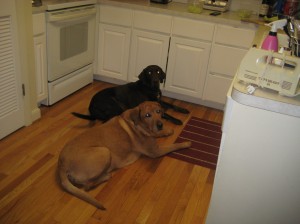Last night at obedience class we were joined by a woman, her husband and her grand-daughter, along with their Rottweiler. They joined our class because when the grand-daughter cries, their dog becomes aggressive and won’t let anyone near her in order to comfort her.
We were a little bit late to class due to indulging in the fabulous St. Patrick’s Day feast that my mom prepared, so when we got there, class was already in progress. My heart sank a bit when I saw the little girl in line with her “Mimi” next to the dog. Don’t get me wrong, I’m all for having children learning how to act around pets, but let’s face it, most of the people are there for a reason and you don’t know how someone else’s dog will react.
This is how the evening progressed, Mimi and the child were walking their dog; at some point the child sat down with Grandpa while Mimi continued to work the dog. The child decided she needed her Mimi and began to cry quite loudly; at this point one of the large dogs (with his owner) approached the area where the child and grandfather were sitting and the dog lunged at the child.
Thank God Sara was there and the owner was quick on the take, the dog was “Downed” and Sara quickly gave the command “Down your dog;” which we all promptly did. The situation was handled very quickly but could easily have gotten out of control.
So what prompted the dog to react in that manner? Truthfully, I think the dog was terrified. The dog has never been around small children and all of a sudden here is something that is making an acute, high-pitched noise. In the wild this would be seen as a threat and the natural response to a threat is to attack. I don’t think the dog saw the child and thought, “Oh look a tasty little morsel, I’ll wait until I get close and then I’ll eat it.” The dog heard the noise and as he approached the little girl, the noise got louder, he could tell where the noise was coming from acted like a dog; because he IS a dog.
Obviously you cannot prepare your dog or yourself for every situation that might ever arise, however I do believe that we can expose our dogs to as many different experiences as possible and try to do so in a manner where we maintain control. In my opinion the earlier you can expose your dog to various situations the better, but as more and more people rescue dogs, that isn’t always an option.
What it means as a dog owner/lover is to think ahead when you will be exposing your dog to something new and think, how might Fido react to this and how you can prepare yourself and your pet so that your new experience is a good experience!





Recent Comments